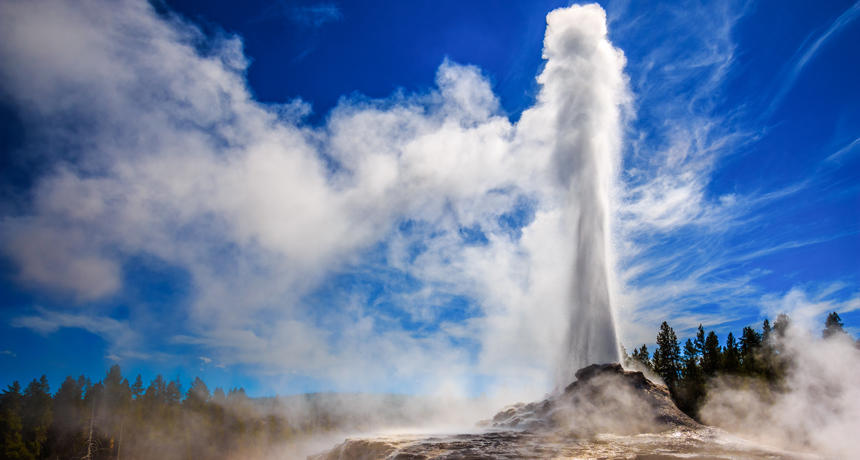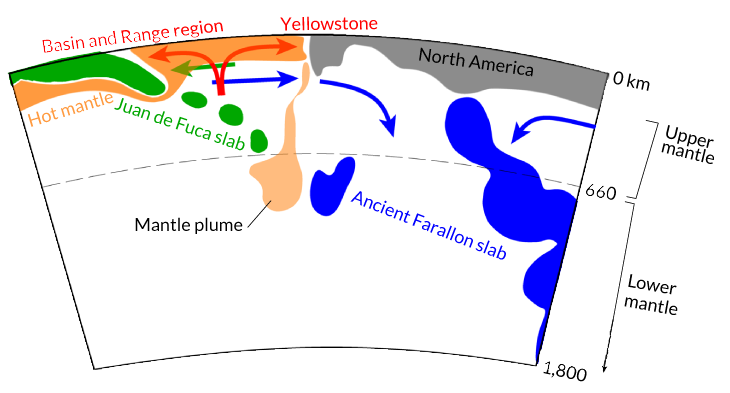
HOT SPOT The Yellowstone supervolcano has a 17-million-year history of eruptions in the western United States. Now scientists say the source of the supervolcano’s heat isn’t a deep mantle plume, but the downward drag of an ancient subducting slab stirring up the mantle.
Riishede/iStockphoto
- More than 2 years ago
The driving force behind Yellowstone’s long and explosive volcanic history may not be as deep as once thought. A new study suggests that instead of a plume of hot mantle that extends down to Earth’s core, the real culprit is a subducting tectonic plate that began sinking beneath North America hundreds of millions of years ago.
Computer simulations show that movement of broken-up remnants of the ancient Farallon Plate could be stirring the mantle in a way that fuels Yellowstone, researchers report December 18 in Nature Geoscience. “The fit is so good,” says study coauthor Lijun Liu, a geodynamicist at the University of Illinois at Urbana-Champaign.
The giant supervolcano now beneath Yellowstone National Park, located mostly in Wyoming, has a 17-million-year history — much of it on the move. In that time, the locus of volcanism has moved northeastward from southwestern Idaho to its current location, where it most recently explosively erupted about 640,000 years ago. These shifting eruptions have created a track of volcanic craters resembling those created by the hot spot that formed the Hawaiian island chain. As a result, scientists have long suspected that a deep plume of magma originating from the core-mantle boundary, similar to the one that fuels Hawaii’s volcanoes, is the source of Yellowstone’s fury.
But the nature of the Yellowstone plume has been the subject of debate. “Usually with plumes, we can trace them to the core-mantle boundary,” says Robert Porritt, a seismologist at the University of Texas at Austin, who was not involved in the new work. To “see” Earth’s structure, seismologists use a technique called seismic tomography, which maps the interior using seismic waves generated by earthquakes. Particularly hot or liquid parts of the mantle slow some seismic waves known as shear waves. Tomographic images of mantle plumes such as the one beneath Hawaii show a low-velocity region that extends all the way down to the boundary between mantle and core, about 2,900 kilometers below Earth’s surface. Such deep plumes are thought to be necessary to provide sufficient heat for the volcanism.
“But at Yellowstone, we don’t have that large low-shear velocity thing at the core-mantle boundary,” Porritt says. Current images suggest a region of low-velocity material extending at least 1,000 kilometers deep — but whether there is a deeper plume is uncertain.
And the region is tectonically complex. About 200 million years ago, a tectonic plate to the west, known as the Farallon Plate, began to slide eastward beneath the North American Plate. The current Juan de Fuca Plate off the Pacific Northwest coast, one of the last remnants of the Farallon Plate, continues to slide beneath the western United States. Some researchers have suggested that, instead of a deep mantle plume, the flexing and melting of the subducting Juan de Fuca Plate are responsible for Yellowstone’s volcanism.
Story continues below diagram
Dragging down
The Farallon Plate began subducting eastward beneath the North American Plate hundreds of millions of years ago. The youngest part of the slab, called the Juan de Fuca Plate (green), now partly lies beneath the western United States. In a new study, simulations suggest that the downward pull of the ancient Farallon Plate (blue) is driving the flow of hot mantle from west to east. As that hot mantle (dark orange) rises through breaks in the Juan de Fuca Plate, some of mantle circulates westward, fueling volcanism in the Basin and Range region. And some flows to the east, fueling Yellowstone.

Liu and his colleagues have yet another idea. In 2016, Liu published research suggesting that the sinking ancient Farallon slab was acting like a lid on a deep mantle plume, preventing the plume from rising to the surface (SN Online: 2/3/16). “But we kept in mind that the problem was not solved,” Liu says. “The heat source [for Yellowstone] was still missing.”
The researchers created a sophisticated, supercomputer-driven series of simulations to try to find the best scenario that matches the three known knowns: the current tomographic images of the subsurface beneath the western United States; the volcanic history at Yellowstone as well as in the nearby Basin and Range regions; and the movements of the subducting slab since about 20 million years ago.
Yellowstone’s volcanism is linked not just to the currently subducting young Juan de Fuca Plate, but also to the remnants of its older incarnation, the Farallon Plate, the simulations suggest. Those remnants have continued to slide deeper and now lie beneath the eastern United States. This downward dive dragged hot mantle eastward along with it. As the Juan de Fuca Plate began to break up beneath the western United States, the hot mantle rose through the cracks. Some of that hot mantle circulated back to the west across the top of the Juan de Fuca Plate, fueling volcanism in the Basin and Range region. And some of it flowed eastward, adding heat to Yellowstone’s fire. The study doesn’t rule out the presence of a deep magma plume, but it suggests that such a plume plays little role in Yellowstone’s volcanism.
Porritt says he’s intrigued by the idea that the sinking Farallon slab beneath the central and eastern United States could be driving mantle circulation on such a large scale. However, he says, he isn’t convinced that the authors have truly solved the larger mystery of Yellowstone’s volcanism — or that a yet-to-be-found deep plume still isn’t playing a major role. “It’s an interesting debate that’s going to be raging, hopefully for decades.”






